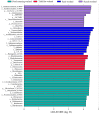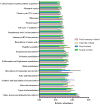Structure and Function of Soil Bacterial Communities in the Different Wetland Types of the Liaohe Estuary Wetland
- PMID: 39458385
- PMCID: PMC11509890
- DOI: 10.3390/microorganisms12102075
Structure and Function of Soil Bacterial Communities in the Different Wetland Types of the Liaohe Estuary Wetland
Abstract
Soil bacterial communities play a crucial role in the functioning of estuarine wetlands. Investigating the structure and function of these communities across various wetland types, along with the key factors influencing them, is essential for understanding the relationship between bacteria and wetland ecosystems. The Liaohe Estuary Wetland formed this study's research area, and soil samples from four distinct wetland types were utilized: suaeda wetlands, reed wetlands, pond returning wetlands, and tidal flat wetlands. The structure and function of the soil bacterial communities were examined using Illumina MiSeq high-throughput sequencing technology in conjunction with the PICRUSt analysis method. The results indicate that different wetland types significantly affect the physical and chemical properties of soil, as well as the structure and function of bacterial communities. The abundance and diversity of soil bacterial communities were highest in the suaeda wetland and lowest in the tidal flat wetland. The dominant bacterial phyla identified were Proteobacteria and Bacteroidota. Furthermore, the dominant bacterial genera identified included RSA9, SZUA_442, and SP4260. The primary functional pathways associated with the bacterial communities involved the biosynthesis of valine, leucine, and isoleucine, as well as lipoic acid metabolism, which are crucial for the carbon and nitrogen cycles. This study enhances our understanding of the mutual feedback between river estuary wetland ecosystems and environmental changes, providing a theoretical foundation for the protection and management of wetlands.
Keywords: bacterial community; bacterial diversity; estuary wetland; functional genes.
Conflict of interest statement
The authors declare no conflicts of interest.
Figures







Similar articles
-
Comparison of rhizosphere bacterial communities of reed and Suaeda in Shuangtaizi River Estuary, Northeast China.Mar Pollut Bull. 2019 Mar;140:171-178. doi: 10.1016/j.marpolbul.2019.01.041. Epub 2019 Jan 25. Mar Pollut Bull. 2019. PMID: 30803632
-
[Bacterial Community Structure and Functional Characteristics of Soil in Carex Tussock Marsh Wetland with Different Degradation Levels].Huan Jing Ke Xue. 2025 Feb 8;46(2):1203-1212. doi: 10.13227/j.hjkx.202403046. Huan Jing Ke Xue. 2025. PMID: 39962696 Chinese.
-
Seasonal variations of soil bacterial communities in Suaeda wetland of Shuangtaizi River estuary, Northeast China.J Environ Sci (China). 2020 Nov;97:45-53. doi: 10.1016/j.jes.2020.04.012. Epub 2020 Jun 5. J Environ Sci (China). 2020. PMID: 32933739
-
[Effects of Land Use Changes on Soil Bacterial Community Diversity in the Riparian Wetland Along the Downstream of Songhua River].Huan Jing Ke Xue. 2020 Sep 8;41(9):4273-4283. doi: 10.13227/j.hjkx.202003088. Huan Jing Ke Xue. 2020. PMID: 33124309 Chinese.
-
A review of factors affecting the soil microbial community structure in wetlands.Environ Sci Pollut Res Int. 2024 Jul;31(34):46760-46768. doi: 10.1007/s11356-024-34132-w. Epub 2024 Jul 5. Environ Sci Pollut Res Int. 2024. PMID: 38967845 Review.
Cited by
-
Seasonality and Vertical Structure of Microbial Communities in Alpine Wetlands.Microorganisms. 2025 Apr 23;13(5):962. doi: 10.3390/microorganisms13050962. Microorganisms. 2025. PMID: 40431136 Free PMC article.
-
Characteristics of methanotrophic communities and their physicochemical driving mechanisms in estuarine and nearshore wetlands of Qinghai Lake.iScience. 2025 Jul 1;28(8):113040. doi: 10.1016/j.isci.2025.113040. eCollection 2025 Aug 15. iScience. 2025. PMID: 40703449 Free PMC article.
References
-
- An J., Liu C., Wang Q., Yao M., Rui J., Zhang S., Li X. Soil Bacterial Community Structure in Chinese Wetlands. Geoderma. 2019;337:290–299. doi: 10.1016/j.geoderma.2018.09.035. - DOI
-
- Andersen R., Chapman S.J., Artz R.R.E. Microbial Communities in Natural and Disturbed Peatlands: A review. Soil Biol. Biochem. 2013;57:979–994. doi: 10.1016/j.soilbio.2012.10.003. - DOI
Grants and funding
LinkOut - more resources
Full Text Sources

